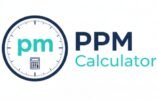PPM ↔ Hz Calculator
Convert between frequency deviation (Hz) and tolerance (PPM).
Enter values and click Calculate.
PPM to Hz Calculator: A Simple Guide for Technicians and Engineers
Have you ever wondered how to convert motor slip from Parts Per Million (PPM) into Hertz (Hz)? This is a common question for electrical engineers, maintenance technicians, and anyone working with AC motors.
Understanding this conversion is crucial for diagnosing motor performance, troubleshooting issues, and ensuring equipment operates within its specifications.
This guide provides a straightforward method and a practical tool for making this conversion accurately and efficiently.
Try: PPM to Survey Error Calculator
How to Convert PPM to Hz: The Core Principle
The conversion between PPM and Hz is directly related to the number of poles in the motor. The formula is:
Hz=(PPM×Number of Poles)÷120
Why does this formula work? The number 120 is a constant derived from a standard electrical equation (F=(120×RPM)÷Poles), making it the essential bridge between slip (PPM) and the frequency deviation (Hz) we’re trying to find.
- PPM (Parts Per Million): This value typically represents the motor’s slip, or the difference between the synchronous speed and the actual rotor speed. It’s often provided by sophisticated motor analyzers.
- Number of Poles: This is a fundamental characteristic of the motor’s design, which you can usually find on the motor’s nameplate. Common pole counts are 2, 4, 6, and 8.
- Hz (Hertz): The output frequency deviation, which tells you how much the motor’s speed is slipping in cycles per second.
This calculator ensures you get consistent ppm measurements every time
Real-World Scenarios Solved by the PPM to Hz Calculation
- Motor Diagnostics: A technician uses a vibration analyzer and gets a slip reading in PPM. By converting this to Hz, they can compare it to known fault frequencies and identify potential issues like bearing wear or unbalance.
- Performance Monitoring: An engineer needs to track the efficiency of a pump motor. They use a handheld device to measure PPM slip. Converting this value to Hz allows them to trend the motor’s performance over time and predict maintenance needs.
- Quality Control: During a factory acceptance test, a motor’s performance is measured in PPM. The result must be converted to Hz to verify it falls within the acceptable tolerance specified in the project’s technical documentation.
For these reasons, having a reliable and quick method to perform this calculation is a game-changer. Our online PPM to Hz Calculator provides a simple, direct solution. Just input your values for PPM and the number of poles, and it instantly provides the result in Hz, eliminating the need for manual calculations and reducing the chance of error.
This tool is designed to be user-friendly, ensuring you get accurate results whether you’re a seasoned professional or just starting out.
